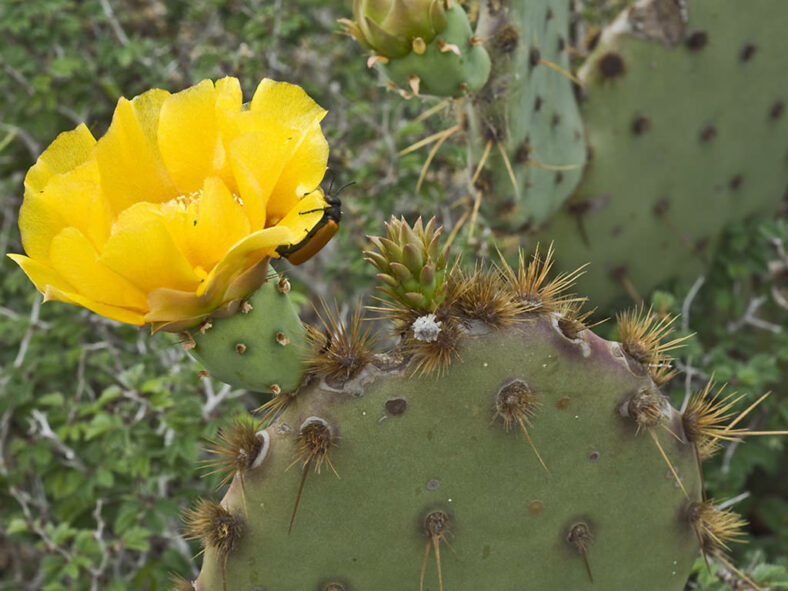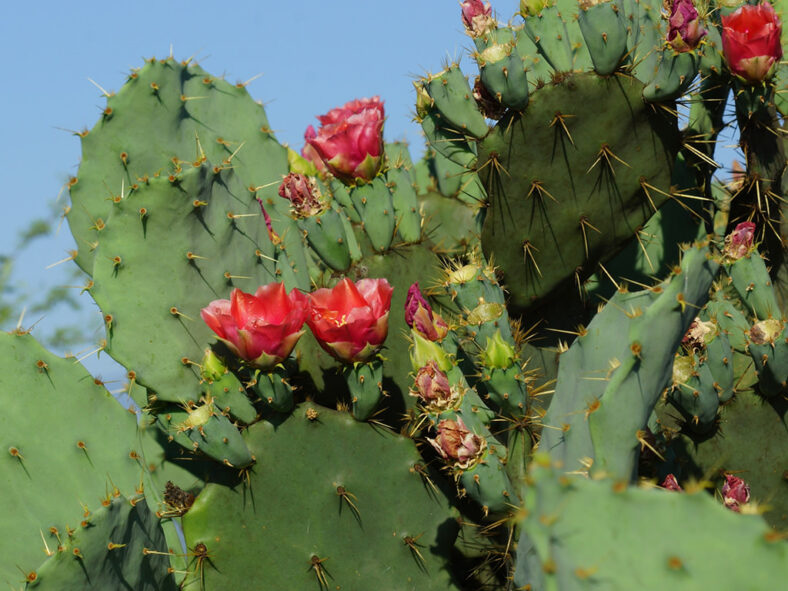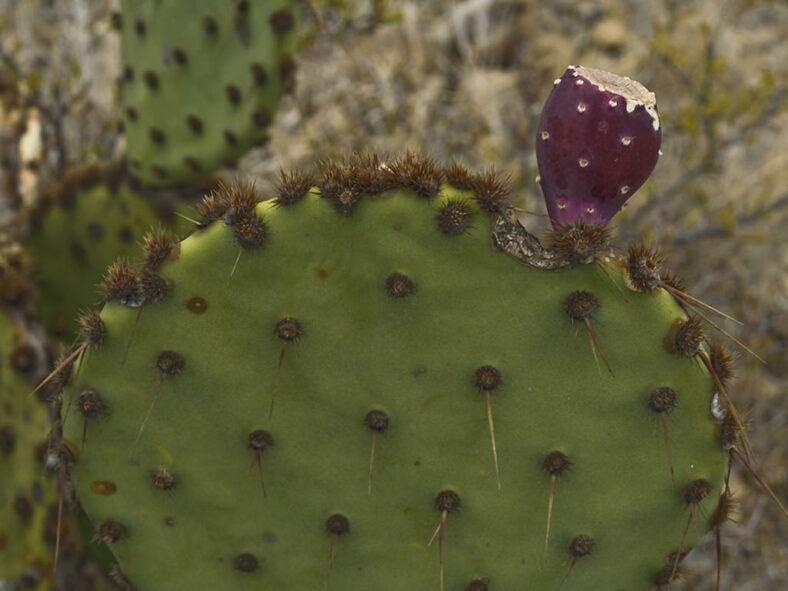Opuntia aciculata is a highly ornamental cactus, often grown in gardens for its attractive flowers and pads.
Scientific Name
Opuntia aciculata Griffiths
Common Name(s)
Chenille Pricklypear, Old Man's Whiskers, Cowboy's Red Whiskers
Synonym(s)
Opuntia engelmannii var. aciculata, Opuntia engelmannii subsp. aciculata, Opuntia lindheimeri var. aciculata
Scientific Classification
Family: Cactaceae
Subfamily: Opuntioideae
Tribe: Opuntieae
Genus: Opuntia
Etymology
The specific epithet "aciculata" (pronounced ass-sik-yoo-LAY-ta) means "furnished with or composed of aciculae; marked with fine irregular streaks like needle scratches" and refers to the conspicuous glochids on the stem segments of this species.
Origin
The native range of Opuntia aciculata is along the Rio Grande in Webb County in Texas, United States, and northern Mexico (Nuevo Leon and Tamaulipas). It grows in dry hills, mainly on stony outcrops, often in small colonies.
Description
Opuntia aciculata, also known as Opuntia engelmannii subsp. aciculata, is a somewhat upright or spreading shrub with branches that consists of jointed flat, deep green pads with characteristic widely spaced glochids radiating like star or pincushion. This cactus can grow up to 3.3 feet (1 m) tall and spread to 6.6 feet (2 m) in diameter, forming hemispherical mounds. The stem segments are subcircular to obovate, measuring up to 8 inches (20 cm) long and 4 inches (10 cm) wide. The spines are commonly absent or evenly distributed, with 1 to 3 per areole. They are straight, yellow or brown, tipped yellow or mottled brown, and can grow up to 2 inches (5 cm) long. The glochids are pale to deep red-brown, sometimes with a yellow tip, measuring up to 0.3 inches (0.8 cm) long.
From mid-spring to early summer, Opuntia aciculata produces large flowers ranging from yellow to orange or deep red (rarely magenta). The flowers appear on the upper terminal margins of pads and can reach a diameter of 3.6 inches (9 cm). The edible fruits are purplish red, spineless, usually pear-shaped, and can grow up to 1.5 inches (3.8 cm) long and 1 inch (2.5 cm) in diameter.

How to Grow and Care for Opuntia aciculata
Light: Opuntia aciculata thrives in full sun, but some shade during midday and afternoon can prevent sunburn in hot climates. A window that receives sunlight 6 hours a day works best when grown indoors.
Soil: This cactus requires a well-draining soil mix. You can use a commercial cactus potting mix or create your own.
Temperature: Opuntia aciculata is highly tolerant of high temperatures and prefers cooler temperatures in winter. It grows best in USDA Plant Hardiness Zones 8a to 10b, with average minimum winter temperatures ranging from 10 to 40 °F (-12.2 to 4.4 °C).
Watering: From spring to fall, water moderately and let the soil dry out completely before watering again. In most areas, rainfall will be enough for established plants. If potted, never let the container sit in water. During the winter, suspend the watering.
Fertilizing: Opuntia aciculata does not need fertilizer when planted in the ground. However, it will benefit from fertilizing during the growing season when grown in a container. Apply a water-soluble fertilizer. Suspend feeding during the winter when the plant goes dormant.
Repotting: Repot only when the cactus becomes potbound or is too large and unstable in its container. Choose a slightly larger container with drainage holes at the bottom. The best time for repotting is late winter or early spring.
Propagation: You can propagate Opuntia aciculata by stem segments or seeds. The easiest method is by stem segments, which yields faster results. Take stem segments in early summer for best results, and sow the seeds in late spring.
Learn more at How to Grow and Care for Opuntia.
Toxicity of Opuntia aciculata
Opuntia aciculata is not toxic to humans or pets. However, keep the plant away from pets and children as it has harmful spines and glochids that may cause skin irritation.
Links
- Back to genus Opuntia
- Succupedia: Browse succulents by Scientific Name, Common Name, Genus, Family, USDA Hardiness Zone, Origin, or cacti by Genus
Photo Gallery
Click on a photo to see a larger version.


